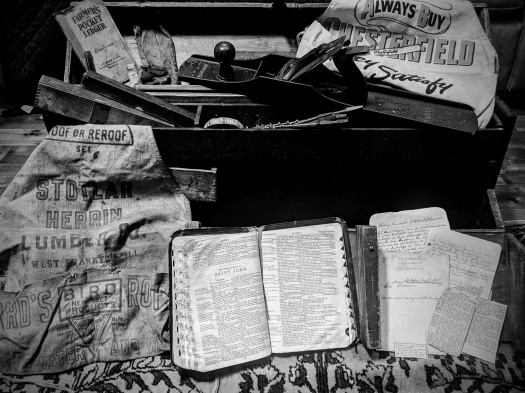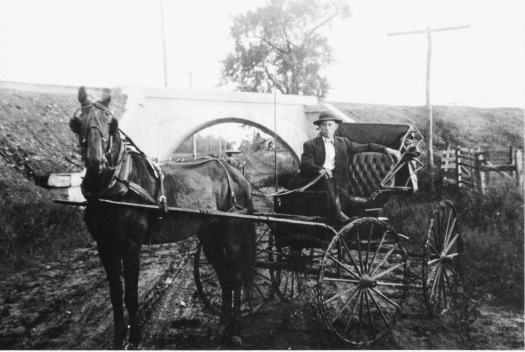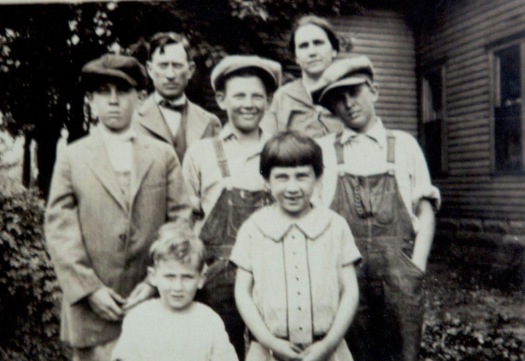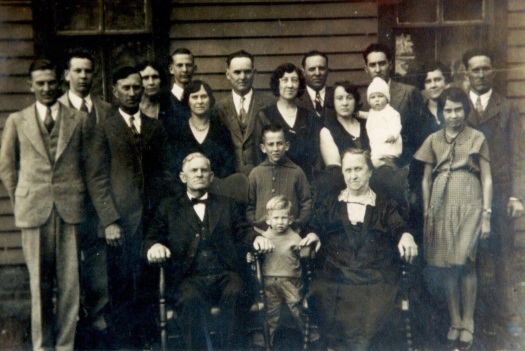“Time is but the stream I go a-fishing in. I drink at it; but while I drink I see the sandy bottom and detect how shallow it is. Its thin current slides away, but eternity remains.”—Henry David Thoreau, Walden
Admittedly, I didn’t have a lot go on. He passed away twenty years before I was born and only a few brief stories were passed down, hardly enough to provide me with the full measure of the man. Recently, I was unpacking some boxes after our recent move and came across a few things that once belonged to my grandfather, Russell Stewart DeLap. He was a carpenter until his death in 1939, and I have his tool box, a few of his tools, and his Bible. As I held these things in my hands, I realized that his blood still runs thick in my veins and perhaps an attempt to know him better would be worth the effort.
Since he died relatively young (age 52 years, 11 months, and 2 days, according to his obituary) and Dad was only ten years old at the time, I didn’t get to hear many stories about his life. I recall hearing him described as a no-nonsense father and a stern disciplinarian. I never detected a hint of resentment when Dad recalled his father—it was more of a “That’s the way it was, back then.” During the Great Depression times were tough, plus I’m sure keeping a brood of eight children under control required a stern approach.
So, who was R.S. DeLap—was there more to him than a handful of recollections?
Starting with a few of the facts, I began to put some color on this canvas. He was born on November 20, 1886 in Norris City, Illinois, the eldest of nine children of Darius A. and Elizabeth (Zuck) DeLap. He spent most of his adult life in West Frankfort, where he worked at his trade and regularly attended Calvary Baptist Church. He married Sarah L. Nolen on September 23, 1909 and went on to have eight children (all but one survived to adulthood). He succumbed to an intestinal infection on October 23, 1939 at Barnes Hospital in St. Louis and lies buried next to Grandmother in the Ebenezer Cemetery at Norris City.
These facts were gleaned from his obituary and the few memories. But there really isn’t much color. A closer look at his bible and tools helped to paint a more vivid portrait of my grandfather.
A family bible can reveal a lot about a person and Grandpa’s was no exception. Let there be no mistake, his faith was an important part of his life. His handwritten notes and the highlighted passages reveal quite a bit. He was a man who worked hard to live a life in keeping with his faith, but they also reveal his struggles to be true to these convictions. I saw my own father struggle with these same demons and desires, and for that matter, so do I.
One particular note revealed the tug of war between living a life of faith and the challenges and temptations of everyday life. He wrote, “This is the way I long have sought and morned [sic] because I found it not a strait and narrow way.” He further wrote, “A narrow way with all my vices.” In the Gospel of Matthew the writer describes the way to salvation as being a straight and narrow path while the path to destruction has a wide gate and broad way (Matthew 7: 13-14). This made him very human to me. Regardless of one’s faith, we all struggle to stay on the “strait and narrow way”, only to stumble off the path.
Another note posed three questions that weren’t that different from the ones I have often pondered myself. “Where did I come from?” “What am I doing here?” and “Where am I going?” These are age-old questions that I think many have pondered at some point. If not, it might be a worthwhile exercise.
Among his papers was a handwritten description of “A true Baptist Church”, which clearly speaks to a fundamentalist view of Christianity. This is an interpretation of scripture that I understand but don’t practice. We would have parted company early in this aspect of our faith. I have always believed that one’s faith is a personal matter, not something to be spoon-fed down a gullible throat. A portion of his obituary read, “Early in life, he manifested religious zeal and lived true to his convictions. He was a consistent member of the Calvary Baptist Church in West Frankfort and his pastor, Rev. Clark, left a revival he was conducting in Rockford in response to a message telling him of the death of one of his most valued members.”
There was the page torn from a hymnal with the song, “Shall We Gather at the River”:
Shall we gather at the river?
Where bright angel feet have trod?
…Yes, we’ll gather at the river,
The beautiful, the beautiful river…
This song makes me wonder if he might have been baptized in the Big Muddy River that flows north of West Frankfort, the Baptist’s believing in full submersion.
I think his faith was summed up in the short note tucked in his bible that says, simply, “Bought May 15, 1924. This Bible means a lot to me.” Was it his first bible, purchased at the age of thirty-seven? Had he lived a rough-and-tumble life and then found religion? Did he walk into the Big Muddy that year and give himself up to the Lord? That history has been lost, but what survives is evidence that he took his faith very seriously—the worn pages of his bible ample evidence.
Life…
Life gets in the way of religion, or it sure as hell complicates matters. As much as we want to follow along the narrow way, the temptations of today and tomorrow often block our path.
One of my favorite songs is John Prine’s “Grandpa was a Carpenter” from his album, Sweet Revenge, released on Atlantic Records in 1973: He built houses, stores, and banks/chain-smoked Camel cigarettes…he was level on the level/shaved even every door…“ Grandpa didn’t smoke Camels, but evidence suggests that he did enjoy his Chesterfields, and I’m confident he shaved even every door.
There is something about holding the tools of his trade in my hands. They make him come alive in ways that marked-up scripture in a bible can’t—it’s his tools that put the flesh on his bones. These are the things of sweat and toil, the things that put bread on the table. It is not just the marks on the paper but the thoughts behind them. What was he thinking as he wrote out the simple mathematics of a day’s work in his ledger? In many ways, this part of his life is much easier for me to grasp.
I can hold his Stanley #608 Bedrock Planer, its wooden handles deeply etched with the oil and dirt of an honest man’s hands. I have the nub of a carpenter’s pencil honed down from each day’s worth of ciphering—its red color still faintly showing through the grit. I can imagine him buying it for pennies at Stollar and Herrin Lumber Company in West Frankfort. There is the tightly rolled Lufkin cloth tape, never stretched out but surely waiting for the next task, or the bag of chalk nubs that I’m sure marked many a board. There are auger bits and the handmade toolbox that held saws, hammers, and the like. A cross-cut saw that cut through many a rick of firewood. He was a working man. He did what had to be done. He raised a family and then left them too soon. The last entry in his ledger was from August, 1939 when he did work for “J. Leacher” for a dollar an hour. His entries end on the 26th of that month. I surmise the illness that eventually took his life ended his carpenter’s trade on that August day. He died just two months later.
Who was Russell Stewart DeLap? I think two lines from his obituary sum up his life rather succinctly:
“Reverend Clark was minister of the congregation when the present large edifice was built and he talked of the actual work and helpful suggestions of Mr. DeLap during the construction, and pointed with pride to his handiwork and suggested improvements.”
“The large church was filled with people who felt the loss of a good neighbor, a true friend, a loyal and consistent church member and an upright citizen.“
He really was the man who would “Level on the level and shaved even every door”. He was a God-fearing, honest man who gave an hour worth of hard work for his dollar of pay.
Here is his life as best as I can piece together—gone now over eighty years, yet still living on in some simple tools, a few pictures, and a time-worn bible. His body lies below a stone in Ebenezer Cemetery, but a spirit reaches out to a grandson he never knew. I have tried my damnedest to make him come alive. I stare deeply into his face in the few pictures I have and see a bit of me in there. I so much want him to step out of those pictures or me into them. I have so many unanswered questions. Have I conjured up fiction or nonfiction? As time passes these lines blur even more, but his bible and tools keep me anchored to a real person, flesh and blood. His wasn’t a life written about in some novel or historical treatise. Short of an obituary in the local paper, he simply passed through this life, largely undetected, except by those who loved and befriended him. Isn’t that the way it goes for most of us?





